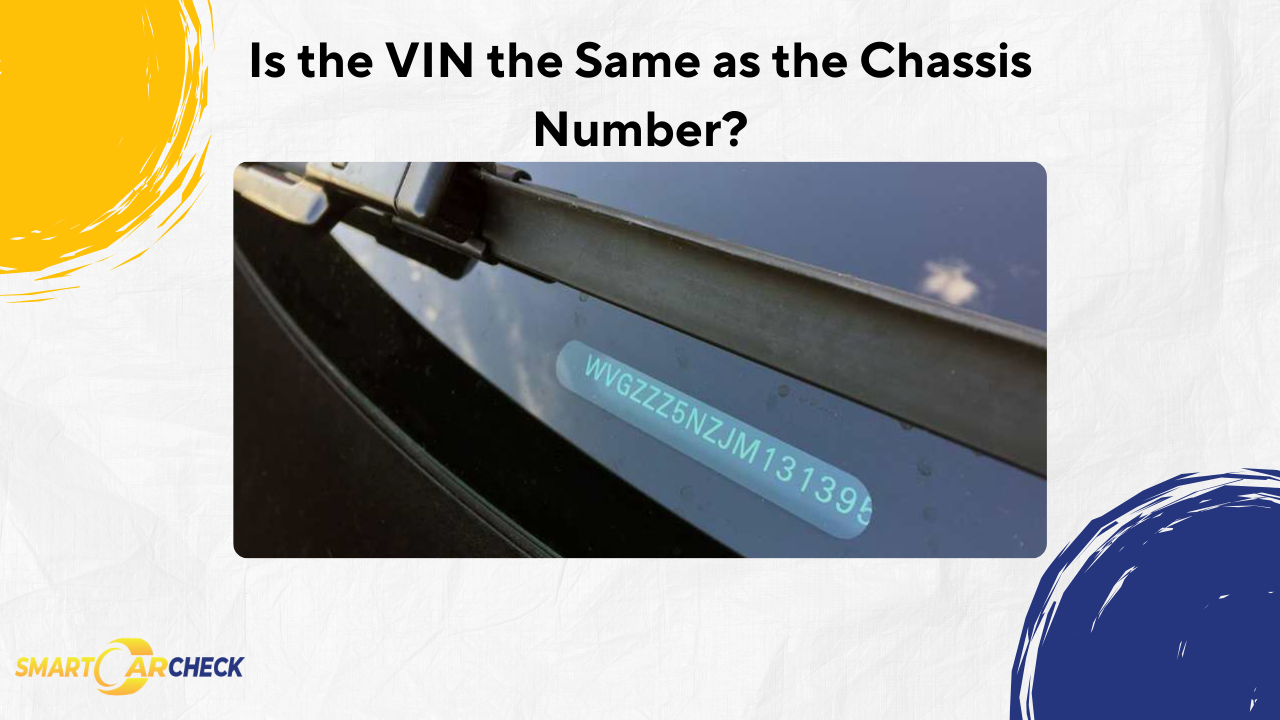Have you ever encountered the terms “VIN” and “chassis number” and wondered if they’re the same thing? You’re not alone! Both terms are used when discussing car identification and mean the same thing.
Both terms are used interchangeably to refer to the exact string of letters; you’ll find out why in this article.
What is a VIN or Chassis Number?
A Vehicle Identification Number often called the chassis number in the UK, is a string of 17 characters used to identify individual motor vehicles among millions of cars. It was first used in 1954 and acts like the vehicle’s fingerprint, containing crucial information about its origin, manufacturer, model, and features.
The first three characters of the VIN are the World Manufacturer Identifier. This identifies the manufacturer and the vehicle’s origin. The following five characters make up the vehicle descriptor section and describe the vehicle’s make, model, engine type, and specifications.
The ninth character is the check digit; the other eight characters comprise the Vehicle Identifier Section (VIS) and represent the model year, manufacturing plant code, and serial number.
Note that the VIN is not always 17 characters. In classic cars manufactured before 1981, for example, the chassis number may be between 5 and 13 characters since the VIN wasn’t standardised then.
Is the VIN the same as the Chassis Number?
Yes, the VIN is the same as the chassis number. You may wonder why most people in one country or region use the term VIN, and others use chassis. Here’s why.
The VIN (Vehicle Identification Number) is often called the chassis number because, historically, the chassis number identified a vehicle’s physical frame or chassis. But as the automotive industry grew and cars became more complex, the need arose for a more comprehensive identifier to store all critical vehicle details, not just its chassis. In 1981, manufacturers began to use VIN to identify every vehicle they make.
The VIN expanded upon the concept of the chassis number by including additional information such as the vehicle’s origin, manufacturer, model, engine type, and more. This led to the VIN becoming the standard globally recognised identifier for motor vehicles. While the VIN became the globally recognised term, the chassis number is still used today to refer to the VIN.
That’s why you may hear the term VIN used in the US and Chassis number in the UK.
Why is the VIN Important?
The VIN serves as a means by which information on a specific vehicle can be accessed and collected. The VIN lets you view any vehicle’s model year, make, model, and history. Here are some importance of the VIN:
- Uniquely Identifies Vehicles: Each VIN is a unique code assigned to a specific vehicle during manufacture. This ensures that no two vehicles share the same VIN, making it a reliable identifier for all cars during their lifespan.
- Vehicle History: With a VIN, car buyers and sellers can access essential information about a vehicle’s history, including specifications, ownership/keeper history, MOT and tax dues, MOT history, vehicle registration details, power, alerts, mileage discrepancies, write-off checks, and more.
- Theft Prevention and Recovery: What happens if a vehicle is stolen? You would report it to the police, right? How do they track your vehicle? With the VIN. Stolen vehicles may get their VINs altered, but with the VIN placed on several parts of the car, the police will find it.
- Regulatory Compliance: VINs are used by regulatory agencies worldwide to enforce safety and emission standards, facilitate vehicle recalls, and ensure compliance with vehicle registration and titling requirements. Manufacturers also use VINs to issue recalls and notify owners promptly about safety defects or non-compliance issues.
- Insurance and Warranty Coverage: Car insurance companies use VINs to calculate premiums accurately based on a vehicle’s specific attributes and to verify the vehicle’s insured value. Similarly, VINs are crucial for verifying warranty coverage and facilitating warranty repairs based on manufacturer specifications.
- Ensuring Authenticity: The VIN is also important in the classic and vintage vehicle industry. With the VIN, you can determine the value and authenticity of classic cars.
How do I find my VIN or chassis number?
If you are buying a used or pre-owned vehicle, decoding your VIN can give you insights into the vehicle’s overall condition and ensure reliability. You can find the VIN:
- On the dashboard near the windshield.
- On the driver’s side door jamb.
- Stamped on the car’s chassis
- Under the hood near the engine.
- Under the spare wheel in the boot.
- In vehicle paperwork, such as V5C logbook, title, insurance policy, and registration documents.
Can the VIN Number be changed?
Although the VIN is meant to remain unchanged for a lifetime, there are rare occasions where the VIN number can be changed, and it usually involves a significant time gap, sometimes even decades. They are:
- When a car is being rebuilt
- When you have a kit car
- When a vehicle is altered and no longer matches the specifications of the original VIN
In most jurisdictions, altering or changing the VIN is illegal due to its critical role in vehicle identification, regulatory compliance, and fraud prevention. If you notice any fraudulent deal, report it to the police immediately or get a VIN check just to be sure.
When should you check a car’s Vehicle Identification Number?
Ideally, you should check the VIN before purchasing a used vehicle. Used cars can have hidden problems, and you don’t expect the seller or dealer to tell you every detail about the cars on sale—they aren’t even legally supposed to. A lookup with a reliable VIN check UK tool, like Smart Car Check, can save time and help you understand a used vehicle’s history down to the last detail. Our VIN check tool is one of the most detailed history report providers at an affordable price. A single VIN check will give you access to the following records:
- Specifications Engine details
- Ownership history
- Logbook check Power delivery and performance
- Weight and dimensions
- MOT and tax dues
- Alerts
- High-risk checks
- Mileage discrepancies
- Write-off check
- Vehicle registration details
- MOT history
- Stolen check
- Outstanding finance check
- Number plate changes
- Cloned plate check
- Colour changes
- And lots more.
You should also check the VIN to see if it matches the one printed on the V5C logbook. If there are any discrepancies, you should do some more investigating.
Is there a difference between VIN, chassis, and engine numbers?
We already know there is no difference between the VIN and chassis number, but are they the same as the engine number? Yes, there is.
Unlike the VIN, the engine number is not fixed to the car in question and can be changed.
The engine number tells what size and power output the engine produces and changes with the engine, that is, new engine, new engine number.
VIN vs. Chassis Number: Same Difference
That’s right. There is no difference between the two terms. Depending on your location, you might find either “VIN” or “chassis number” being used more commonly. Both terms refer to the same 17-character code.
The VIN decoder is a vital tool for buyers, sellers, law enforcement, and anyone who wants to know a car’s history. For an accurate and affordable VIN check, simply enter the VIN into the form on this page and get a detailed report.


